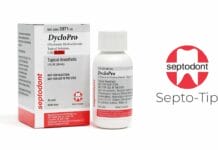Cancer is the second leading cause of death in the United States. According to the CDC, 598,038 people died from some form of cancer in 2016. Of those deaths, approximately 10,000 were from oral cancer. That number may seem minor in comparison, however, consider this – 10,000 deaths a year is approximately one death per hour, every 24 hours.
The American Cancer Society estimates there will be 53,000 new cases diagnosed and 10,860 will die from oral cancer in 2019. These statistics are for the United States; worldwide the burden is much higher. Oral cancer is one of the most prevalent cancers worldwide. The current estimates by the World Health Organization are 657,000 new cases and 330,000 deaths from oral cancer worldwide. Though we have more knowledge than ever about causes, treatments, and screening, oral cancer statistics have not improved in decades. The survival rate remains quite grim at approximately 65%; this is much lower than many other cancers such as breast (90%), melanoma of the skin (92%), and testicular (95%).1,2,3,4
Early diagnosis of oral cancer improves survival rate to 84%. Unfortunately, only 29% of oral cancer is diagnosed at this early stage. If the cancer is diagnosed at a later stage when it has spread to other parts of the body the survival rate decreases to 39%.4 These statistics are evidence that early detection is crucial to improve survival rate.
Risk Factors
Risk factors for oral cancer include tobacco use, alcohol consumption, and HPV infection. HPV is thought to cause 70% of oropharyngeal (back of the throat including the base of the tongue and tonsils) cancers; it generally takes several years after being infected with HPV for cancer to develop.5 Studies have shown a better survival outcome in HPV-related oropharyngeal cancer when compared to non-HPV related oropharyngeal cancer.6 This should not overshadow the fact that 75% of all head and neck cancers are related to alcohol and tobacco use.7
Oral Cancer Screening and Assessment
As clinicians, we need to be thorough in our assessment of every patient, starting with reviewing health history and risk factors. Though most oral cancers are diagnosed in older men, age and gender should not deter a thorough cancer screening. Important risk factors would include tobacco use, alcohol consumption, history of head and neck cancer, and history of HPV infection.
A thorough oral cancer screening can be performed in 5 minutes or less. The examination should include taking note of any asymmetry, swelling, lesions, pigmentation, raised or ulcerated areas. This includes the face, eyes, nose, ears, and neck in addition to the oral cavity. In addition to visual evaluation, palpation is necessary to feel swollen lymph nodes or other masses that may not be detected visually.
Adjunctive screening devices have also proven to be helpful when performing an oral cancer screening. Adjunctive screening devices include toluidine blue, fluorescence visualization, chemiluminescence, brush biopsies, and salivary testing. Adjunctive screening devices can aid in early diagnosis, which provides a better treatment outcome.
Toluidine Blue
Toluidine blue has been reported to effectively help in the diagnosis of dysplasia and early malignant lesions that are not clinically recognizable. This method has been reported to have good sensitivity with a low rate of false negatives. Toluidine blue is a metachromatic nuclear dye of the Thiazine group. It selectively stains certain tissues particularly tissues with nucleic acids, such as DNA and RNA; this process is useful because dysplastic areas contain more DNA.
The process of doing an adjunctive screening with toluidine blue would require several steps with a possible follow up. The patient would be required to rinse with water, then rinse with an acetic acid solution for 20 seconds, the area would then need to be dried, after drying, toluidine blue solution is applied to the suspected lesion. Finally, the patient would need to rinse again with acetic acid followed by water. After the patient has done the final rinse if there is positive staining on the lesion the procedure will need to be repeated in 1-2 weeks. A biopsy is recommended for any positive stained areas upon re-evaluation at 1-2 week follow up.8
Fluorescence
Fluorescence visualization has shown great promise as an adjunctive screening device. The mechanism of fluorescence visualization involves fluorophores within the oral epithelium and stoma which absorbs UV and visible light. This allows some of the light to re-emit at longer wavelengths in the form of fluorescence. By using an absorbing filter to block reflected illumination light, it is possible to see longer wavelength fluorescence with the naked eye. Fluorescence visualization is sensitive to changes in the morphology and biochemistry associated with neoplasia. Oral cancer and precancer display a loss of autofluorescence; these tissues appear dark brown or black while normal healthy tissue emits a pale green autofluorescence.
Fluorescence visualization relies on the clinician’s ability to recognize a loss of fluorescence. Because this could attribute to some false positive, fluorescence visualization should be considered a screening device and not a definitive diagnostic tool. Certain lesions or conditions such as inflammation, ulceration, and pigmentation show loss of autofluorescence making it difficult to distinguish these benign lesions from neoplastic lesions. Studies show fluorescence visualization achieves a sensitivity of 98%, which makes it a useful adjunct screening device for experienced clinicians, but some studies question its value as a general screening device.9
Chemiluminescence
Chemiluminescence has been used for years in obstetrics and gynecology for early detection of cervical cancer and precancer. It has recently been introduced to oral oncology for the early detection of oral cancer and precancer. Chemiluminescence is a single-use kit that consists of 1% acetic acid solution, a capsule that emits light and a retractor sheath and handle. The acetic acid solution acts as a cytoplasmic dehydration agent; it removes debris and disrupts the glycoprotein barrier allowing penetration of the light. This will cause the light to be absorbed by normal mucosal cells and is reflected by abnormal dysplastic and neoplastic cells, making these areas appear white. This procedure, like toluidine blue, requires several steps which require rinsing with 30 mL of 1% acetic acid solution for 1 minute, activate and assemble light capsule, dim ambient light, and examine the oral cavity.
There are conflicting findings regarding the efficacy of chemiluminescence. Most studies agree that chemiluminescence is more accurate in detecting leukoplakia (white lesions) than erythroplakia (red lesions). Yet, another study indicated it did not detect any lesions regardless if they were red or white. The sensitivity, specificity, and effectiveness of this technique remains undetermined.10
Brush Biopsy
Brush biopsy is a noninvasive procedure used to acquire tissue samples of a lesion. Brush biopsies are performed using a circular bristle brush to obtain epithelial cells of a suspected lesion. Brush biopsies collect epithelial cells from all three layers: superficial, intermediate, and basal. For highly inflamed or ulcerative lesions topical anesthesia may be necessary, depending on the patient’s comfort level. To properly collect the sample the flat end of the brush should be used in most cases, apply firm pressure, and rotate ten times or more. For ulcerations, it is recommended to sample the periphery of the lesion and not the center of the ulcer. After the sample is obtained, the cells will need to be transferred to a slide and fixed. In most cases the sample will be sent to a lab for evaluation. Brush biopsies are easy to perform, painless, and can be used on all suspicious lesions. Studies indicate a sensitivity and specificity rate of 90% with this technique.11
Salivary Testing
Saliva has been referred to as the mirror of overall health. Salivary testing can provide information related to many local and systemic diseases and conditions. With recent technology advances, saliva has the potential to replace blood, serum, and cerebrospinal fluid as a tool for diagnosis. Tumor markers such as oncogenes, anti-oncogenes, cytokines, growth factor, and interleukin, along with several other markers, can be found using salivary testing.
There are several collection methods that include spitting, suctioning, and collection on an absorbent material. The sample is then sent to a lab for detection of tumor markers. Saliva-based oral cancer diagnosis has reported an 85% accuracy rate.11 As of mid to late 2018, there are no FDA approved salivary diagnostic tests for evaluating the risk of head and neck cancers.12
Closing Thoughts
In the past when doctors knew very little about the cause of oral cancer. Health care providers were unsure if oral cancer was a genetic disease or caused by a virus. If a suspicious lesion was detected, patients would need to undergo a painful biopsy to determine if the lesion was cancerous. Most oral cancers were diagnosed at a very late stage; treatment included radiation to shrink the tumor and surgery to remove the remaining tumor. Quality of life was not good after the often-disfiguring surgery.
Today, we know the risk factors for oral cancer are tobacco use, alcohol consumption, and HPV infection. Scientists have discovered, like most cancers, oral cancer is caused by mutations that disrupt the genes that control the normal cell growth cycle. Scientific discoveries and advancement in technology have provided dental professionals with the ability to use chair-side tools to better assess oral lesions before suggesting a surgical biopsy. These tools have reduced the number of unnecessary surgical biopsies while also improving early diagnosis. It is worth mentioning again that early diagnosis is crucial to improving survival rates.
Future goals set by the National Institute of Dental and Craniofacial Research include more public awareness and education to improve early detection, making salivary testing more routine, improved treatments using targeted molecular therapy and personalized medicine, and improved cure rates. With improved knowledge, science, and technology these goals are certainly attainable.
All healthcare providers can contribute by ensuring all patients receive an oral cancer screening twice a year. The need for more availability to the previously discussed screening tools at public health clinics would also prove to be an advantage for early diagnosis. Medical, dental and specialty practitioners, will need to work together to educate patients on the importance of oral cancer screening better. Working together, we can certainly improve the sad statistics that are associated with oral cancer.
SEE ALSO: The First Line of Defense Against Oral Cancer
Resources
- American Society of Clinical Oncology. Breast Cancer: Statistics. Retrieved from https://www.cancer.net/cancer-types/breast-cancer/statistics/2015
- American Society of Clinical Oncology. Melanoma Statistics. Retrieved from https://www.cancer.net/cancer-types/melanoma/statistics
- American Society of Clinical Oncology. Testicular Cancer: Statistics. Retrieved from https://www.cancer.net/cancer-types/testicular-cancer/statistics
- American Society of Clinical Oncology. Oral Cancer: Statistics. Retrieved from https://www.cancer.net/cancer-types/oral-and-oropharyngeal-cancer/statistics
- Centers for Disease Control. HPV and Oropharyngeal Cancer. Retrieved from https://www.cdc.gov/cancer/hpv/basic_info/hpv_oropharyngeal.htm
- Lai, K., Killingsworth, M., Matthews, S., Caixeiro, N., Evangelista, C., Wu, X., Wykes, J., Samakeh, A., Forstner, D., Niles, N., Hong, A., Lee, C.S. Differences in Survival Outcome Between Oropharyngeal and Oral Cavity Squamous Cell Carcinoma in Relation to HPV Status. J Oral Pathol Med. 2017 Sep; 46(8): 574-582. Retrieved from https://www.ncbi.nlm.nih.gov/pubmed/27935119
- Silverman, S. Demographics and Occurrence of Oral and Pharyngeal Cancers. JADA. Volume 132, 7S-11S. Retrieved from https://jada.ada.org/article/S0002-8177(14)65284-3/fulltext
- Ali, F.M., Prasant, M.C., Ashok, P., Kedar, S., Vinit, A., Safiya, T., Deshpande, R. Diagnostic Test for Cancer Detection in Dental & ENT Clinics: The Toluidine Blue Test. JK-Practitioner. 2012; 17(4): 47-49. Retrieved from http://medind.nic.in/jab/t12/i4/jabt12i4p47.pdf
- Shin, D., Vigneswaran, N., Gillenwater, A., Richards-Kortum, R. Advances in Fluorescence Imaging Techniques to Detect Oral Cancer and its Precursors. Future Oncol. 2010 Jul; 6(7): 1143-1154. Retrieved from https://www.ncbi.nlm.nih.gov/pmc/articles/PMC2929485/
- Shashidara, R., Sreeshyla, H.S., Sudheendra, U.S. Chemiluminescence: A Diagnostic Adjunct in Oral Precancer and Cancer: A Review. J Cancer Res Ther. 2014 Jul-Sep; 10(3): 487-91. Retrieved from http://www.cancerjournal.net/article.asp?issn=0973-1482;year=2014;volume=10;issue=3;spage=487;epage=491;aulast=Shashidara
- Omar, E. Current Concepts and Future of Noninvasive Procedures for Diagnosing Oral Squamous Cell Carcinoma – A Systemic Review. Head Face Med. 2015; 11:6. Retrieved from https://www.ncbi.nlm.nih.gov/pmc/articles/PMC4396078/
- American Dental Association. Oral Health Topics: Salivary Diagnostics. Retrieved from https://www.ada.org/en/member-center/oral-health-topics/salivary-diagnostics












